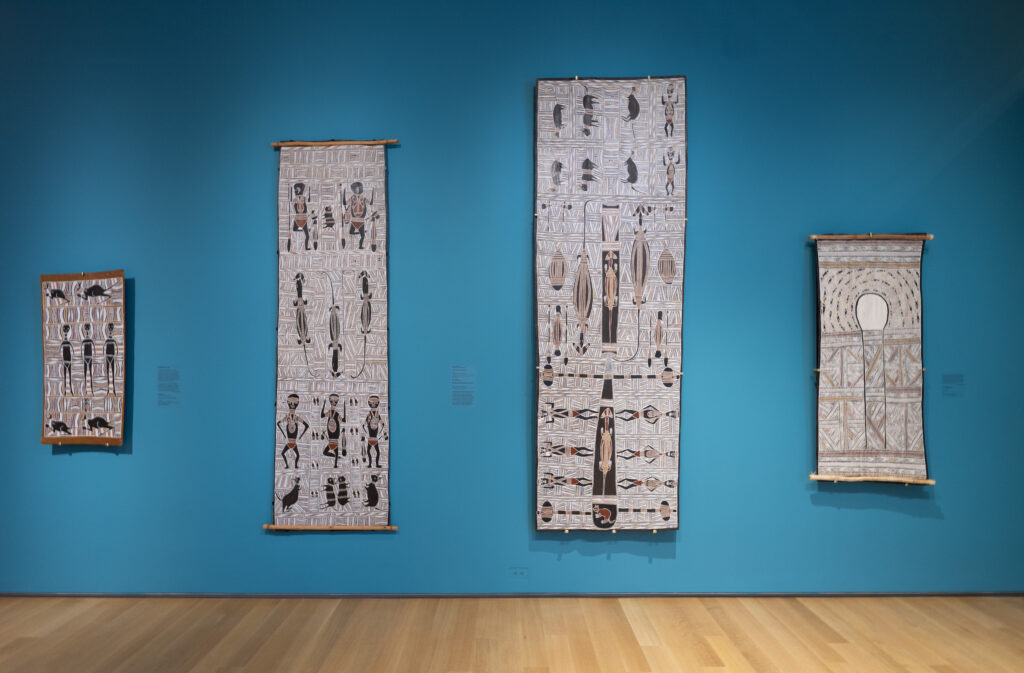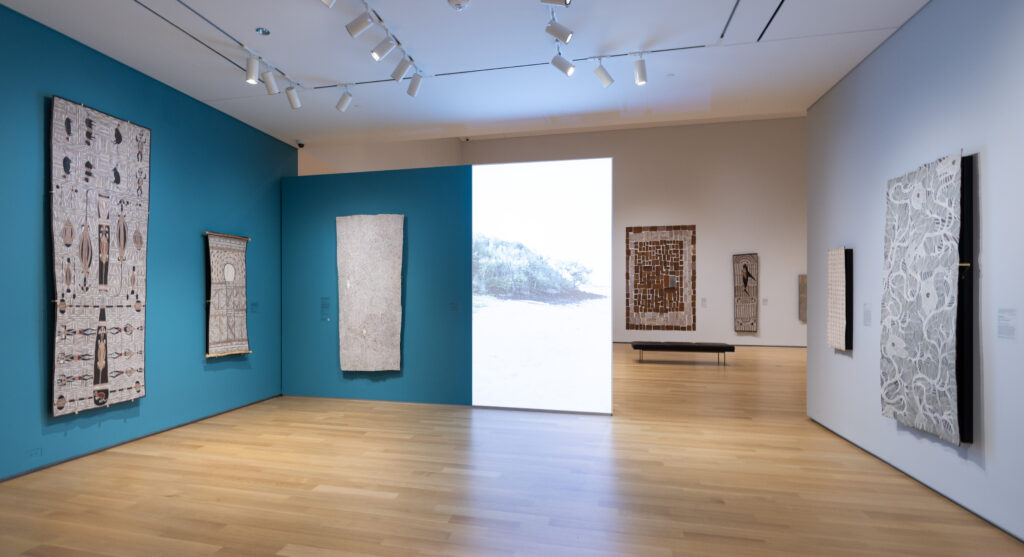
On Sept. 3, the Hood Museum of Art debuted its newest exhibition: “Maḏayin: Eight Decades of Aboriginal Australian Bark Painting from Yirrkala.” Organized by the Kluge-Ruhe Aboriginal Art Collection of the University of Virginia in partnership with the Buku-Larrŋay Mulka Centre in Australia, “Maḏayin” makes history as both the first major exhibition of Aboriginal Australian bark painting in the United States and the largest display of Aboriginal Australian art in the Western Hemisphere in 30 years.
“Maḏayin” allows the Yolŋu people to convey the stories of their culture, families and heritage. Many of these stories originated in Yirrkala, the northeast Arnhem Land in Australia’s Northern Territory. “Maḏayin” is the first exhibition for which Yolŋu people have been asked to participate in the curating and decision making processes. According to Wakun Waṉambi, artist and Yolŋu co-curator of Maḏayin, no Yolŋu have ever curated before this exhibit — it was a job for the “non-Yolŋu” who do not understand the rich history of these paintings in the same way the Yolŋu do. This partnership allows for the unique, authentic voices of Indigenous Australian people to be displayed in an American museum.
In the opening remarks of the exhibition’s media event, Hood Museum director John Stomberg said that the exhibition has undergone a long journey.
“[“Maḏayin”] is a project that our colleagues at the Kluge-Ruhe have been working on for seven years, but a tradition that goes back much farther,” Stomberg said. “I think one way of thinking about this exhibition, this art, these wonderful paintings, is that it is a beautiful flower, with roots that go down 80,000 years.”
According to the information displayed on the walls throughout the exhibition, the Yolŋu have a deep culture that was confusing to follow at times. However, in curating “Maḏayin,” the Yolŋu people organized the pieces according to their kinship system, called gurruṯu. Gurruṯu is known to the Yolŋu people as raki, or string, and it is how all Yolŋu people are connected. The raki also applies to the land, sea, creatures and plants. Through this interconnectedness, the Yolŋu people have great knowledge of the land and the sea; they belong to the land and everything in their world through gurruṯu.
The Yolŋu people have another way of classifying their pieces throughout this exhibit. All Yolŋu clans belong to the Dhuwa or the Yirritja, complementary groups, or moieties. Yolŋu people must marry someone from the opposite moiety, and Yolŋu children always take their father’s moiety. Each artist on display in “Maḏayin” belongs to one of sixteen different clans; eight are Dhuwa and eight are Yirritja.
Henry Skerritt, curator of Indigenous arts of Australia at the Kluge-Ruhe Collection, explained that this exhibition is about relationships.
“It’s about families,” Skerritt said. “It’s about speaking across cultures, but it’s about doing it in your own words, about respecting each other’s way of seeing the world.”
Upon entering the exhibition, viewers are greeted by a full-wall projection of the ocean waves in Australia. On the adjacent wall there is a quote by Wukun Waṉambi, a recently deceased artist and member of the exhibition’s curatorial team.
“Like the surface of the water, beneath is an ocean of knowledge,” Waṉambi said. “We can only show you the surface.”
This quote sets the expectation for the exhibition before viewers move upstairs to view and appreciate 80 bark paintings that explain the rich history of the Yolŋu.

For decades, the Yolŋu people have painted their clan designs on themselves and other ceremonial objects. These ancestral land designs of intricate patterns are maḏayin, a term that means sacred and beautiful. With some paintings standing over 12 feet tall, the paintings are created on sheets of eucalyptus bark using natural pigments. Although the color scheme of these paintings only consists of a few natural colors, the patterns and meanings behind these paintings are vibrant, drawing viewers in to learn and understand.
“Maḏayin” incorporates older pieces dating back to 1935 and some newly commissioned paintings created by Yolŋu Aborigial Australian artists specifically for the exhibit. As visitors move throughout the exhibit, they will also experience the use of film. Produced by Ishmael Marika, a Yolŋu filmmaker and integral person in the curation of “Maḏayin,” there are four floor-to-ceiling projections of Yolŋu ceremonial dance. The combination of new media and sacred, ancestral paintings blend beautifully.
During the press event for “Maḏayin,” Ishmael and Djuwakan Marika, a Yolŋu father and son team, ceremonially performed a song about birds before viewers were guided through the exhibition and given an authentic history of a few specific bark paintings.

“Destiny” (2019) is a piece by Wukun Waṉambi, a member of the Marrakulu clan. From far away the piece looks like dots on a large piece of eucalyptus bark. However, as the viewer moves in closer, the detail of hundreds of small fish becomes clear. Through this piece, Waṉambi tells the story of a fish called Wawurritjpal that swims through the water, wondering where his path is. Going alone at first, the fish traveled from river to river until he found his own family. Then, the fish returned to the rock and laid down his spirit with his family.
According to Djuwakan Marika, a Yolŋu musician, dancer, artist and the grandson of the great artist Wandjuk Djuwakan Marika, “Destiny” displays more than just the story.
“It brings the rain,” Marika said. “[The Yolŋu] typically like stories. Story comes with the songlines.”
The designs presented by the Yolŋu people make viewers feel the Yolŋu’s rich tradition and family ties, while also providing a platform for them to educate viewers in a setting that has never heard the voices or stories of these people.
Will Stubbs, the director of the Buku-Larrnggay Mulka Arts Centre in Yirrkala, Australia summarized the power and beauty of “Maḏayin.”
“This exhibition traces the trajectory of sharing by allowing people who will never understand the intricacies of Yolŋu culture a window into what might exist on that other side of that fence through the power of visual art,” Stubbs said. “This is ‘Maḏayin’: sacred, secret, law and maḏayin, beauty.”
“Maḏayin” will remain at the Hood Museum of Art until Dec. 4. After Dartmouth, the exhibition will embark on a nationwide tour.